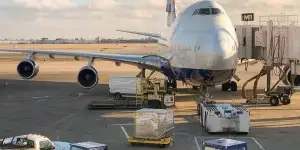With their impressive processing speed, convenience, and intelligent answers they bring to daily life, the rapid growth of ChatGPT is probably the closest thing to proving how the advancement of AI and machine learning is practically sweeping many people off their feet. In the supply chain, their wide applications in data-driven processes such as cloud platforms and scenario planning for supply chain management are also getting increasingly critical.
An immediate and inevitable negative impact amid these exciting developments in AI technology, however, is that such widespread adoption of advanced, internet-based technology also signifies a markedly higher risk of cyber exposure in the supply chain. Learn more about the cyber risks in the supply chain, their impact, and ways to mitigate these cyber risks in the supply chain in the following sections.
Table of Contents
1. What are the cyber risks in the supply chain
2. Impact of cyber risks on the supply chain
3. How to mitigate cyber risks in the supply chain
4. A cyber-safe supply chain
What are the cyber risks in the supply chain

Before identifying the cyber risks in the supply chain, it’s worth noting that while all these risks fall under the broader scope of Cyber Supply Chain Risk Management (C-SCRM), C-SCRM involves a holistic approach with policies, procedures, and technologies to manage these risks. Our focus here, however, is on the specific types of cyber risks, major potential vulnerabilities, threats, and immediate mitigation steps. The cyber risks in the global supply chain ecosystem can be fundamentally divided into internal and external types:
Internal cyber risks in the supply chain
The first and most common type of internal cyber risk involves various types of cyber security incidents related to human errors in the supply chain. As proven by multiple studies, notably both Verizon’s 2023 and 2024 Data Breach Investigations Report, which highlighted that 74% and 68% of cyber breach incidents involve a certain human element. Human oversight is among the most prevalent issues, from incorrect sharing permission settings and falling victim to phishing links to misdelivery of sensitive data and connecting to unsecured networks that are vulnerable to hackers’ attacks. Even weak passwords, delays in software updates, and unauthorized physical access to secure areas can result in the theft or viewing of sensitive information.
If all the above human errors are accidental or careless mistakes, the next most common type of cyber risks in the supply chain, while still involving humans, is much more intentional with deliberate malicious actions taken by any insiders– any trusted individuals of a business with access to sensitive systems and data. Insider threats such as data theft, sabotage through data deletions or alterations, malware installation, and information leaking for espionage purposes, as well as unauthorized access to systems or manipulation of information for personal gain, are unfortunately among the common cyber risk examples too.
Finally, but equally important, infrastructure or system susceptibility represents another prominent internal cyber risk type in the supply chain since it greatly enhances the chances that the critical systems to be subjected to potential hacking or breaching issues. Outdated software or poorly configured security systems also contribute to supply chain vulnerabilities, as they can compromise overall security and efficiency if left unaddressed.
External cyber risks in the supply chain

External cyber risks in the supply chain, naturally, involve human elements too and, similar to insider threats, are most prevalent among the third-party vendors to a company, such as suppliers, partners, contractors, and service providers. They may accidentally or intentionally divulge sensitive info to competitors, maliciously expose the company’s systems, or even engage in cyber espionage. This threat is particularly concerning due to the fact that many logistic systems or online platforms grant third parties certain access to provide collaborative info for goods delivery or shipment real-time tracking.
Furthermore, shippers may also need to log in to third-party platforms to operate or manage the logistics processes from time to time. The most common examples of such platforms or access include enterprise resource planning (ERP) systems and customer relationship management (CRM) platforms.
Meanwhile, cyber-attacks are another significant external risk in the supply chain with social engineering attacks such as phishing and baiting being the most widespread, and yet victims normally easily fall for these types of attacks. While there are at least five common social engineering attacks, they are not the only way to deliver malicious software like malware and ransomware. Drive-by downloads, where users unintentionally download something without even realizing it, are one of the most common cyber risks, whereas email attachments, removable media, such as USB drives/USB ports, and bundled software are among the most critical external cyber risks in the supply chain as well.
Impact of cyber risks on the supply chain

The heavy reliance on cloud technologies and digital platforms in modern supply chains magnifies the magnitude of the impacts of various cyber risks. Whether they are internal or external types of cyber risks, the impact on the supply chain field is most significantly reflected in 3 primary aspects: operational disruptions, financial consequences, and reputational damages.
Operational disruptions such as downtime, delays, and the subsequent loss of productivity are almost certainly the inevitable impact as a result of both internal and external risks, which cause system failures and network interruptions. Consequently, financial consequences include both direct and indirect costs such as data breaches and recovery expenses, which are becoming increasingly burdensome, leading to higher, substantial overall costs in the supply chain. Finally, the end result of these issues is reputational damage, and loss of trust among customers, suppliers, and stakeholders, which severely affects brand valuation and impacts long-term business growth.
How to mitigate cyber risks in the supply chain

Cybersecurity policies
Since human errors lead to the most frequent and damaging cyber risks, be it for internal management or external oversight of cyber threats, it’s imperative to start by establishing minimum cybersecurity standards for both employees and suppliers. A comprehensive cybersecurity policy must also cover the response and mitigation strategies in case of cybersecurity breaches, any cyber attacks, as well as hardware, system, or infrastructure failure. Regular cybersecurity drills can be conducted as part of internal employee training to evaluate and reinforce their full understanding and compliance with the policies.
Regardless of whether it’s for suppliers, vendors, other third parties, or internal employees, companies can help ascertain that they all maintain high levels of vigilance and preparedness for the company’s cybersecurity policies by providing continuous, regular cybersecurity policy training, and awareness programs.
Network security

Enhancing network security is an evidently effective solution in mitigating potential or imminent cyber risks in the supply chain, even though it is often overlooked either due to negligence or budget constraints. Network security improvements can be approached from two primary dimensions: software and hardware. From a software perspective, it involves the deployment of various types of software programs, such as antivirus and anti-spyware programs, security monitoring software, data loss prevention software, and firewall software, along with regular updates and patching to safeguard against vulnerabilities. Software enhancements also include stricter practices for logging into sensitive systems through stronger password requirements and multi-factor authentication, which aim to fortify security at the application level.
Simultaneously, from a hardware perspective, deploying advanced defense mechanisms such as robust firewalls, comprehensive endpoint protection systems, and intrusion detection systems is crucial. These hardware solutions monitor and protect network traffic from malicious activities together with software solutions. The network security advancement ultimately contributes to building secure, multi-layered security protection across different endpoints and networks, creating an overall robust defense system against any cyber threats for all users.
Third-party management

Different from the first mitigation idea related to cybersecurity policies, this is specifically dedicated to managing all related third parties who have access to critical systems. In other words, aside from having comprehensive and up-to-date cybersecurity policies covering these third parties, businesses should also conduct thorough and regular risk analyses and assessments on all involved third-party vendors in the supply chain to enhance existing security measures. Such regular practice and evaluation are also vital in identifying high-risk third parties, making it easier to control the size of this at-risk group, or even further limit their numbers for more efficient management and oversight.
The end goal of this strategy is to develop a comprehensive, highly coordinated disaster recovery plan that is workable across different parties and allows each supply chain partner to collaborate effectively, ensuring all parties’ business continuity together. This collective approach ensures a robust, synergistic defense against potential cyber threats.
Continuous resilience

Similar to any other critical effort in the supply chain, cybersecurity is an ongoing process that requires continuous effort to regularly review and update the related risk management and contingency plans to stay current with advancements in the cybersecurity field. This is especially indispensable since cyber attacks and data breaches are becoming increasingly sophisticated in order to exploit victims and achieve their nefarious ulterior motives.
It’s therefore paramount for businesses to learn from any past incidents, whether from their own previous experiences or those that occurred in the industry, to initiate relevant ongoing training that further sharpens knowledge and skills in improving future defenses and ensures continuous resilience. Besides continuous monitoring and assessment, implementing proactive approaches with security measures such as advanced firewalls, intrusion detection systems, and endpoint protection remain among the best practices to mitigate and prevent cyber risks in the supply chain.
A cyber-safe supply chain

As more supply chain systems and processes go online or become cloud-based, cyber risks such as cyber-attacks and human-error-induced incidents, including insider threats and third-party vulnerabilities, are becoming increasingly widespread nowadays. These cyber-threats impact the supply chain field operationally, financially, and reputationally, causing significant disruptions and damage.
To effectively mitigate these risks, businesses must establish a thorough cybersecurity policy that covers the corresponding response mechanisms in the event of a cyber incident. Enhancing network security, including both software and hardware upgrades, and implementing robust third-party management to better control the size, access rights, and privileges of vendors and suppliers are two other recommended mitigation strategies to reduce cyber risks. In addition, in order to create a cyber-safe supply chain environment, all organizations must stay vigilant and committed to maintaining continuous resilience in cybersecurity risk management.
Discover more innovative logistics solutions and wholesale business strategies at Alibaba.com Reads regularly, and elevate your business operations with these expert tips and ideas designed to drive success today.

Looking for a logistics solution with competitive pricing, full visibility, and readily accessible customer support? Check out the Alibaba.com Logistics Marketplace today.




